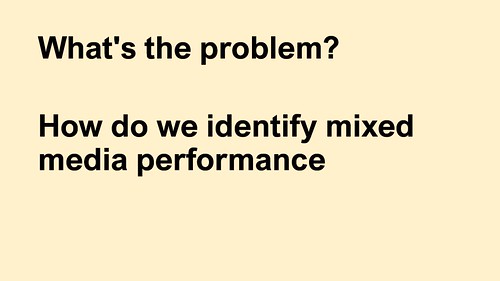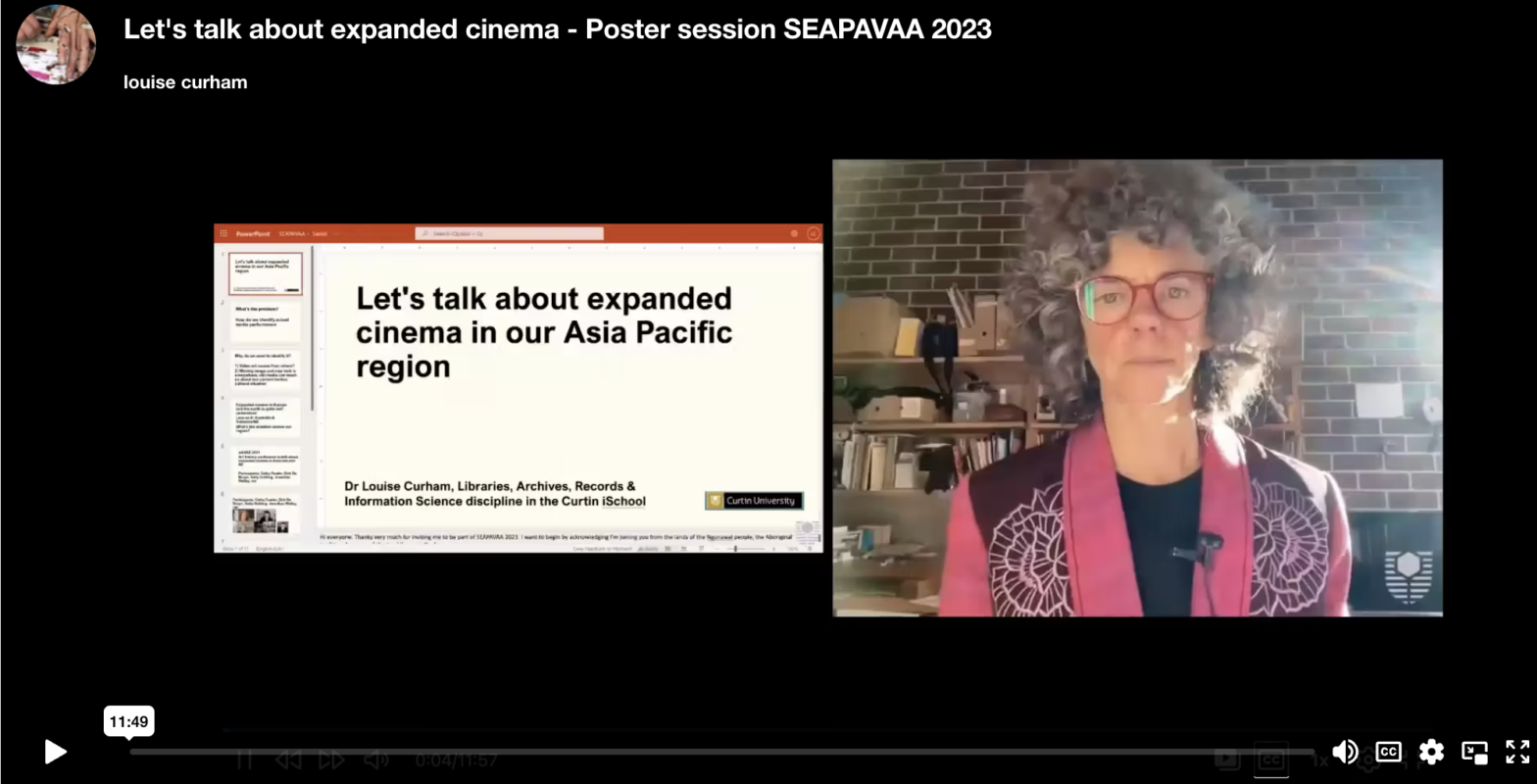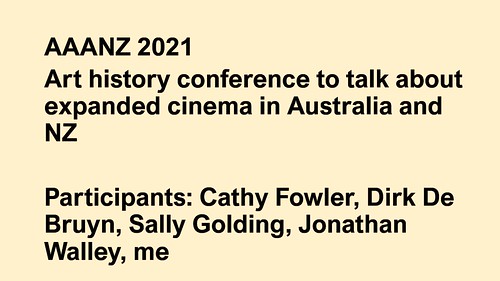Dr Louise Curham from Curtin University’s iSchool starts a dialogue with audiovisual archivists of South East Asia about expanded cinema.
Here’s the recording of this talk:
And here’s what I say (not quite identical but pretty close)
Hi everyone. Thanks very much for inviting me to be part of SEAPAVAA 2023. I want to begin by acknowledging I’m joining you from the lands of the Ngunawal people, the Aboriginal traditional owners of this land I’m on in Canberra.
SLIDE 2

I’m here to talk about expanded cinema. I’ve been making, investigating and talking about expanded cinema for two decades as an artist, audiovisual archivist and more recently, as a scholar. What is expanded cinema? Its name can be traced to the American book from 1970 by Gene Youngblood, Expanded Cinema. It can be described as performance involving moving image media which activates the space in front of the projector lens.
I’ve spent time finding out about Australian work but quite a lot of my effort has been focused on British expanded cinema. Works like these from the Global North are well known well understood and accepted, and increasingly, collected and archived. From my recent investigations, the situation in Australia and New Zealand is mixed, a situation I have a hunch is similar across our Asia Pacific region. That’s why I’m here to start a dialogue with you about these works.
In this short talk I’m going to explain why these works matter, I’m going to report back on 2021 dialogues about this work in Australia and Aotearoa NZ and some of the reasons we uncovered for why this work is not well known.
SLIDE 3

Why does this work matter? A recent book from the Tate on conceptual art in the UK sets out the link from expanded cinema to video art. The link is significant, there’s much to do to understand it better. But it’s not just the link to video art that’s important. Societies are dealing with the ever-increasing complexity of technology. Understanding how the public has engaged with new technology over time, including through the use of technology by artists, is important for us to understand the ethics and the impact of technology. That’s a big claim for artists getting out 16mm projectors in the late 60s and 70s, that they can help us understand our current techno-cultural situation but as that technology became available, it made sense to artists to do that. We know this because it’s been discussed a lot with regard to these works in Europe in the UK and in Japan. So their engagement is an important say for us to explore the impact of these technologies.
SLIDE 4
In 2021 I was involved in a dialogue over 6 months with a group of artists, scholars and film programmers. Those dialogues showed that there are small groups who know about these works. Particularly important are people who’ve been involved in the communities that have produced them – the artists themselves. And this is where you, the AV preservation community, come in. My own experience with AV preservation tells me that those who must literally wind through the films, check the mag media and enter data into collection systems get to know about works and histories in a unique and valuable way. That’s my motivation for this conversation with you.
Insights from AV preservationists may be immensely valuable for a field like expanded cinema. This is because the works are hard to locate. In part, that’s because the language to describe them is mixed. Calling them expanded cinema is not something that has been systematically applied. The case study for this is the work that Dr Cathy Fowler at Otago University has been doing about scenes in New Zealand. Cathy’s work showed that seeking something called expanded cinema doesn’t get your far. But seeking something with 16 mm and live performance, for example, Super 8 and live performance, gets you further. But of course, those kinds of categories, such as ‘live’ can’t always be called up from collection management systems. One route is trawling through publications, exhibitions catalogues, film festival programs and conversations. But I hope reports from your practical contact might be another route.
SLIDE 5
So, now I’m going to talk you through what we learn from our dialogue in 2021 and some of the themes that emerged. The dialogues were prep for the annual art history conference for Australia and NZ. For some months we met each fortnight to establish our common understanding. Sally Golding was part of this group. She is an Australian artist who spent 10 years in London and really led the experimental film scene and the expanded cinema community in London. The language that Sally used for her Unconscious Archives program was audio-visual performance. This goes by many names, noise, the experimental music scene, the expanded cinema scene. Some people might call it the handmade film scene or the artist-run film labs scene. Sally describes herself as an artist who focuses on networks.
Also in the conversation was Dirk De Bruyn. Dirk is a long-standing member of Australia’s experimental Film Community, an artist and scholar. He’s written quite extensively about experimental film, both, in Australia, and internationally.
Also on the panel was Dr. Cathy Fowler who had begun inquiries into the histories of experimental film in New Zealand and some of the examples she shared in that panel were really exciting. For example, Leon Narby’s Super 8 film performance installation from the 1980s, that happened at the opening of the Govett Brewster gallery. The fourth person involved in that panel was Jonathan Walley who is the author of Cinema Expanded, a really comprehensive book about expanded cinema practices, mostly from the Global North.
My own skin in this game is through my super 8 performance artworks. My investigations to try to find precedents for that Led me to 60s and 70s expanded Cinema. Notable for me was Jeffrey Shaw’s piece Corpocinema, but I soon found the London Filmmakers Co-op works and in my collaboration with artist Lucas Ihlein as Teaching and Learning Cinema we have taken up a practice of re-enacting these works, extending to preservation through re-enactment. So all five of us on that panel had skin in the game in different ways. 
SLIDE 6

I’ve mentioned we uncovered some interesting themes around visibility.
I’ve explained naming can hide – looking up expanded cinema delivers mixed and unrewarding results. Looking up 16 mm live, mixed media – again it’s hit and miss, so this is patient work as Cathy found trawling through the Alternative Film newsletter in New Zealand.
The other thing we discovered through Dirk’s work to look into what’s happened to Super 8 works made in Melbourne was that disheartenment is a risk for preservation.
There was a very vibrant super 8 film scene in Melbourne through the 80s and early 90s but there are few formal archives. Dirk sought to get work digitised but met challenges – artists were incredulous there could be interest in the work decades later when it had languished without attention for so long. Not all works were expanded cinema, many were experimental film. When it came to actually handing over their films, Dirk noticed a pattern emerging where the film makers never quite got round to it. And what we discerned here was that they didn’t really think anyone would take them seriously and they couldn’t really see the point in sharing that work. The low status of these works seems hardwired into the environment. That disheartenment as a risk for preservation really interests me.
Cathy also discovered the importance of scenes to uncovering work in New Zealand. The way audio-visual performance has emerged has really been through local communities – a ‘night’, people show up with gear and a new work gets made. The scenes in New Zealand through the 70s and 80s were quite distinct, in part because of the geography of New Zealand where it’s not so easy to travel between cities. The works don’t necessarily stand well alone, they made sense as part of the events they were made for. To use a high profile example, works like Anthony McCall’s Line Describing a Cone, originally made for a room of people and cigarette smoke, is quite different encountered as a continuous video projection in a white cube. How do we go about meaningfully archiving scenes, bringing the vibrancy and complexity into being in the future? I have some ideas around that from my re-enactment work but for now I’m going to leave it at noting that as a challenge archiving scenes.
The final point that we landed upon was the challenge of how to actually tell these histories. From our discussions we resolved the story needs to be polyvocal with lots of voices in order to capture the vibrancy. They need to be non-hierarchical – we don’t want to establish a cannon. What we’re looking for are lists, a kind of comprehensive account because a scene is made up of its many parts and without those parts, you cut down the value overall. We explored different models for making connections – to bring edges together and to address different experiences of value for what we expect is an uneven, fragmented story.
SLIDE 7 
So why does this stuff about visibility, naming problems, disheartenment and the kind
of histories we want to tell impact on preservation? What we’re doing is capacity building for preservation. We’re not yet at the point where we can actually preserve these works because we don’t yet know what the works are. Compare that with for example, the London Filmmakers Co-op, there’s a whole lot of work about the history of that place and scene that’s gone on that enables the value to get expressed by, for example, collecting institutions, acquiring and caring for those works. So of course, the challenge with our media, with acetate film, magnetic tape, early video formats etc is that they won’t wait. We haven’t got another 50 years to sit on our hands and see what happens. We need to explore how we can bring these histories into visibility now. I gave you my sales pitch for why that’s really important about us understanding, technology, engaging with technology ethically, understanding video art’s roots and how we’ve arrived at these uses of media.
So I’m really hoping that I can open a dialogue with you about these futures of expanded Cinema. I hope we can build a dialogue and partnerships to explore these histories across our region together. Thanks for listening.
References
Curham, L., & Golding, S. (Convenors.). (2021). Let’s talk about expanded cinema [panel in the Art Association of Australia and NZ 2021 conference]. https://www.aaanz21.live/panels1/panel-4
Duguet, A.-M., Klotz, H., & Weibel, P. (Eds.). (1997). Jeffrey Shaw: A user’s manual, from expanded cinema to virtual reality = Jeffrey Shaw: eine Gebrauchsanweisung, vom expanded Cinema zur virtuellen Realität. Cantz, see Corpocinema , photographed in Amsterdam, 1967, p 8.
McCall, A. (1973) ‘Line Describing a Cone’ in Lightshow, Museum of Contemporary Art Sydney July 2015, https://www.mca.com.au/artists-works/exhibitions/light-show/
Straw, W. (2004). Cultural Scenes. Loisir et Société / Society and Leisure, 27(2), 411–422. https://doi.org/10.1080/07053436.2004.10707657
Walley, J. (2020). Cinema expanded: Avant-garde film in the age of intermedia. Oxford University Press.
Wilson, A., & Tate Britain (Gallery) (Eds.). (2016). Conceptual art in Britain 1964-1979. Tate Publishing.
Youngblood, G. (1970). Expanded Cinema (First edition). Dutton. https://archive.org/details/expandedcinema
Additional resources
Barton, C. (2014). ‘Post-object and conceptual art – The rise of post-object art’, Te Ara – the Encyclopedia of New Zealand, http://www.TeAra.govt.nz/en/interactive/43829/real-time-1970 (accessed 2 May 2023), for information about Leon Narby’s Real Time.
De Bruyn, D. (2023). The Shoring Project. [single frame animation of the Melbourne Super 8 Film Group newsletters 1986-2000]. https://vimeo.com/user16477524
De Bruyn, Curham, L & Zuvela, D. (In press). ‘Ghost Writing – where is Australian experimental film?’ in Handbook of Experimental Film, eds. J Walley and K Knowles. Palgrave Macmillan.
Golding, S. (2018). Parsing Digital: Conversations in Digital Art by Practitioners and Curators. Austria: Austrian Cultural Forum London
Ihlein, L., & Curham, L. (2015). Reaching Through to the Object: Re-enacting Malcolm Le Grice’s Horror Film 1. Performance Matters, 1(1–2), 24–40. https://performancematters-thejournal.com/index.php/pm/article/view/14



